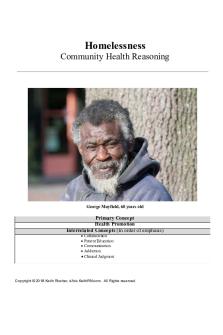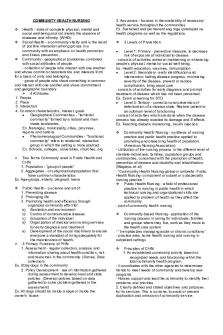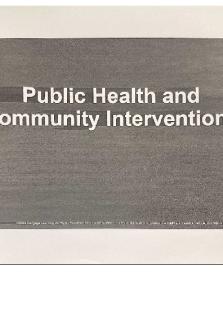Chapter 1- Health and Community with pictures PDF

| Title | Chapter 1- Health and Community with pictures |
|---|---|
| Course | Community Health Nursing |
| Institution | Chamberlain University |
| Pages | 11 |
| File Size | 452.3 KB |
| File Type | |
| Total Downloads | 53 |
| Total Views | 153 |
Summary
Notes on what is community health nurses and how they serve the community along with with is a faith community nurse....
Description
Health and Community
Public Health
Preventing disease Prolonging life Promoting health and efficiency through organized community effort
Community Health
Extends the realm of public health to include organized health efforts at the community level through both government and private efforts.
Cure
Spending additional dollars for cure in the form of health care services does little to improve the health of a population.
Prevention
Spending money on prevention does a great deal to improve health and decrease the dollars spent on cure.
Population-Based Focus
Work on behalf of aggregates (communities) Understand social determinants of health. Gather information and statistics to make decisions. Be part of the solution to find ways to solve persistent health problems. Emphasize society’s responsibility for health. Empower people to help themselves.
Community- Based Nursing
caring for individuals, families, and groups where they live, work or go to school. Setting-specific Emphasis is on acute and chronic care.
“Reimagine the Nursing Process”
Interchangeable term is PATIENT. Replace with Community. Treat the big picture!
Community Assessment
Define Community- Who are you treating? Aggregate: Community composed of people who have common characteristics, for example: o Senior citizens o Ethnic backgrounds o Religious organizations Community of solution: common problem unites individuals Location in space and time o Physical location frequently delineated by boundaries and influenced by the passage of time. o Census tracts subdivide larger communities. o Geographic community can encompass less formalized areas that lack official geopolitical boundaries. Social system: Interrelationships of aggregates fulfilling community functions.
Sources of Data
Windshield Survey o Descriptive approach that assesses several community components by driving through a community. It provides a descriptive overview of a community. o Locate possible areas of environmental concern through “sight, sense, and sound”. o Examples: Who is on the street?, Where is the community located?, How old are the homes?/ Census Data o How has time changed the community? Vital Statistics o Annually compiled, who is in the community? The National Center for Health Statistics o Local, regional, and state government reports o Locally generated
Complete a Needs Assessment
What is the community perspective? o Interview key community informants o Use community forums, focus groups, or surveys. Four types of needs to assess. Expressed needs. o Demand for services and the market behavior of the targeted population Normative needs o Lack, deficit, or inadequacy of services determined by health professionals. Perceived needs o Wants and desires expressed by audience. Relative needs
o Gap showing health disparities between advantaged and disadvantaged population Who holds the power? o Interpersonal (personal empowerment) o Intragroup (small group development) o Intergroup (community) o Interorganizational (coalition building) o Political action Collect data about the community and its members. o Complete a needs assessment and identify community strengths and weaknesses. o Assess the availability of community resources. o List potential sources for program funding (charitable giving, fund-raising, grants). o Evaluate secondary health data.
12- Steps
Diagnosis
Is the time to synthesize the assessment data and create list of actual and potential problems to develop a community diagnosis. Analyze data to determine health needs. Work with community members, local health professionals and administrators to develop priorities and establish outcomes. In setting priorities among identified community problems, consider the following. o Community awareness of the problem o Community readiness to acknowledge and address the problem. o Available expertise/fiscal resources o Severity of the problem o Amount of time needed for problem resolution.
Planning
Determine the intervention levels o Subsystem, aggregate system, and/or suprasystem. Plan interventions for each system level o Primary, secondary, or tertiary levels of prevention Validate the practicality of the planned interventions according to available resources o Personal, aggregate, and suprasystem. Develop interventions to meet identified outcomes. Determine possible solutions to meet the health need. Compare the resources and interventions required for each solution, and select the best option. Establish goals and objectives for the selected solution. o Objectives are behaviorally stated, measurable, and include a target date for achievement. Select strategies/interventions to meet the objectives. Plan a logical sequence for interventions by establishing a timetable. Identify who will assume responsibility for each intervention. Determine available and needed resources to implement interventions. Assess the personnel needed and any special training required for screening or providing education. Determine funding opportunities for needed interventions and develop a budget. Plan for program evaluation.
Implementation
Carry out the plan. Initiate interventions to achieve goals and objectives according to program plan. Monitor the intervention process and the response of the community in terms of values, needs, and perceptions.
Intervention
Often the most enjoyable stage for the nurse and the clients Implementation should follow the initial plan. Should include a variety of strategies Prepare for unexpected problems Consider using all types of media to disseminate information
Evaluation
Important component of success or failure of project o Include the participant’s verbal or written feedback and the nurse’s detailed analysis o Reflect on each previous stage to determine the plan’s strengths and weaknesses o Communicate follow-up recommendations Process evaluation = formative evaluation
o Did we do things the way we said we would? Summative evaluation = product evaluation and outcomes o Did we achieve our goals? Both forms of evaluation should include: o Adequacy o Efficiency o Appropriateness o Cost-benefit analysis Examine the success of the interventions. Evaluate strengths and weaknesses of the program. Determine achievement of desired outcomes. Examine the adequacy, efficiency, appropriateness, and cost benefit of the program. Recommend and implement modifications to better meet the needs of the community. Share findings and recommendations with community members and stakeholders. Ongoing evaluation is necessary in order to ensure program success (sustainability) and meet the changing needs of the community.
Community Diagnosis
Increased risk of (disability, disease, etc.) among (community or population) related to (etiological statement) as demonstrated in (health indicators). o Risk of [specific problem or risk in the community ] among [the specific population that is affected by the problem or risk] related to [strengths and weaknesses in the community that influence the problem or risk]. o Example: Risk of low birth weight among adolescents who are pregnant in the downtown district related to low income, lack of availability of nutritious food, and tobacco use as evidenced by lack of secure housing, food bank use, increased rates of unemployment, and smoking among pregnant adolescents. In community, we can also have a wellness diagnosis by replacing Increased risk of with Increased potential. o Example: Increased potential for positive infant outcomes among teenage mothers related to effective parenting as evidenced by increased participation in mother–baby practice sessions and positive newborn-care behaviors.
PHN Intervention Wheel
Is population based. Contains 3 levels of practice. o Individual o Community o System Identifies 17 public health interventions.
Surveillance
Describes and monitors health events through ongoing and systematic collection, analysis, and interpretation of health data for the purpose of planning, implementing, and evaluating public health interventions o Individual- Medical Record, Chronic Illness Management programs for Diabetes, CHF o Community- Trends in Populations, specialized programs in areas where specific diseases are prevalent. For example, Zika and Chikungunya monitoring in Florida and Southern States, Lyme Disease and Frostbite warnings in Northern States.
o System- Nationally Notifiable Diseases- Which are they?
Disease and other Health Event Investigation
Systematically gathers and analyzes data regarding threats to the health of populations, ascertains the source of the threat, identifies cases and others at risk, and determines control measures. o Individual- Occupational Health Risks o Community- Exposure to radiation or pollution or water contamination o System- Environmental Protection Agency
Outreach
Locates populations of interest or populations at risk and provides information about the nature of the concern, what can be done about it, and how services can be obtained o Individual: High-risk health behavior education, like smoking and drinking in teens o Community: DARE Programs, MADD o System: Federal laws on the legal age for buying alcohol and cigarettes.
Screening
Identifies individuals with unrecognized health risk factors or asymptomatic disease conditions in populations. o Individual: Regular check-ups and screenings like for blood pressure or STDs o Community: Health Fairs to catch those without regular access to care o System: Annual Check-ups and primary care screenings covered at no cost under federal and commercial insurance plans.
Case Finding
Locates individuals and families with identified risk factors and connects them with resources o Individual: Encouraging smokers/tobacco to quit smoking for heart health (for themselves and their families) o Community: Jumpstart Heart programs in schools o System: Cardiac health Programs, like CHF monitoring at no cost through insurance plans
Referral and Follow up
Helps individuals, families, groups, organizations, and/or communities identify and access necessary resources to prevent or resolve problems or concerns o Individual- Home PT after a hip replacement o Community- Organization-based programs that provide transportation to follow-up appointments. o System- Short-term/Long-term disability coverage for health conditions, applications for temporary federal assistance
Case Management
Optimizes self-care capabilities of individuals and families and the capacity of systems and communities to coordinate and provide services o Individual- Rehabilitative programs to re-learn independent living skills o Community- Caretaker programs for the elderly to do check-ups and provide companionship/assistance with ADLS o System- Meals on Wheels to deliver meals to those that cannot leave their homes independently.
Delegated Functions
Direct care tasks a registered professional nurse carries out under the authority of a health care practitioner as allowed by law o Individual: Providing Wound Care service as a home health care nurse o Community: Providing pamphlets for foot care education at a diabetic clinic o System: Creating specific practice standards for foot care and continuing education courses.
Health Teaching
Communicates facts, ideas, and skills that change knowledge, attitudes, values, beliefs, behaviors, and practices of individuals, families, systems, and/or communities o Individual: Teaching about food choices to promote healthy weight o Community: Biggest loser competitions and community exercise programs o System: Specialty programs that provide weight loss incentives for those with elevated BMI (insurance discounts)
Counseling
Establishes an interpersonal relationship intended to increase or enhance capacity for selfcare and coping with a community, system, and family or individual o Individual: Holding a patient’s hand during a scary procedure o Community: Support groups and networking of those with traumatic experiences o System: Mental Health Coverage included in Insurance plans at equal rates to Physical conditions.
Consultation
Seeks information and generates optional solutions to perceived problems or issues through interactive problem-solving with a community, system, and family or individual
o Individual: Working with a patient with vision impairment to modify daily care as needed o Community: Availability of low-vision clinics o System: Specialty programs for vision impaired adults for vocational training.
Collaboration
Commits two or more persons or organizations to achieve a common goal through enhancing the capacity of one or more of the members to promote and protect health o Individual: A nurse gathering clothing donations for a patient who has lost their home. o Community: A church group working with local government to provide supplies to those in need o System: Red Cross and FEMA working together after a hurricane
Coalition Building
Promotes and develops alliances among organizations or constituencies for a common purpose. o Individual: A social worker connects a lonely, widow with a single mother with no family support. o Community: A Business owner and Farmer working together to create a farm to table restaurant in a low-income area. o System: Government, Business and Farmers working together to create an inner-city farmer’s market
Community Organizing
Helps community groups identify common problems or goals, mobilize resources, and develop and implement strategies for reaching the goals they collectively have set o Individual: A long-term care nurse arranges transportation for a patient to their dentist appointment o Community: A nurse connects with a school of dentistry to provide care for a school in a low-income area o System: State health department arranges for free dental care delivery in schools across the state
Advocacy
Plead someone’s cause or act on someone’s behalf, with focus on developing the capacity of the community, system, and individual or family to plead their own cause or act on their own behalf. o Individual: A home health care nurse calls a doctor about a patient’s overwhelming multiple medication regimen.
o Community: A nurse advocates for the inclusion of individuals with different abilities into a community sport’s league. o System: A nurse works on a group position statement with the American Nurses Association.
Social Marketing
Uses commercial marketing principles and technologies for programs designed to influence the knowledge, attitudes, values, beliefs, behaviors, and practices of the population of interest o Individual: Providing a pamphlet for an early intervention program to a mother of a child newly diagnosed with autism. o Community: Passing out flyers on sexual health practices on a college campus. o System: Creating a mass media campaign for anti-tobacco information
Policy Development and Enforcement
Places health issues on decision-makers’ agendas, acquires a plan of resolution, and determines needed resources, resulting in laws, rules, regulations, ordinances, and policies. Policy enforcement compels others to comply with laws, rules, regulations, ordinances, and policies. o Individual: A nurse works to change a rule at school that reduces the frequency of times children can drink water during the day. o Community: A nurse runs for city council o System: Florida nurses association advocating on state health needs in congress....
Similar Free PDFs

Community health final
- 14 Pages

Community Health Nursing RLE
- 15 Pages

Community Health Diagnosis
- 136 Pages

ATI Community Health Focus
- 24 Pages

Health and wellness Chapter 1
- 3 Pages

ATI Community Health Study
- 22 Pages

Community Health Nursing Kaplan
- 41 Pages
Popular Institutions
- Tinajero National High School - Annex
- Politeknik Caltex Riau
- Yokohama City University
- SGT University
- University of Al-Qadisiyah
- Divine Word College of Vigan
- Techniek College Rotterdam
- Universidade de Santiago
- Universiti Teknologi MARA Cawangan Johor Kampus Pasir Gudang
- Poltekkes Kemenkes Yogyakarta
- Baguio City National High School
- Colegio san marcos
- preparatoria uno
- Centro de Bachillerato Tecnológico Industrial y de Servicios No. 107
- Dalian Maritime University
- Quang Trung Secondary School
- Colegio Tecnológico en Informática
- Corporación Regional de Educación Superior
- Grupo CEDVA
- Dar Al Uloom University
- Centro de Estudios Preuniversitarios de la Universidad Nacional de Ingeniería
- 上智大学
- Aakash International School, Nuna Majara
- San Felipe Neri Catholic School
- Kang Chiao International School - New Taipei City
- Misamis Occidental National High School
- Institución Educativa Escuela Normal Juan Ladrilleros
- Kolehiyo ng Pantukan
- Batanes State College
- Instituto Continental
- Sekolah Menengah Kejuruan Kesehatan Kaltara (Tarakan)
- Colegio de La Inmaculada Concepcion - Cebu








